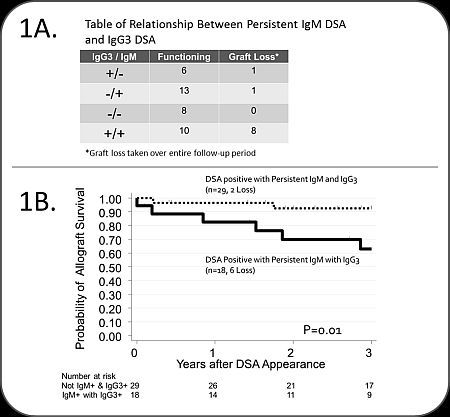Identifying the Most Dangerous DSA: A 12-Year Longitudinal Post-Transplant Study of IgM, IgG, and IgG Isotype HLA Alloantibodies in Primary Renal Transplant Recipients
Terasaki Foundation, Los Angeles, CA
East Carolina University, Greenville, NC
Eastern Nephrology and Associates, Greenville, NC
Meeting: 2013 American Transplant Congress
Abstract number: 169
Due to the lack of longitudinal serum collection in transplant patients, the natural history of the humoral response is undocumented and may reveal why many but not all patients with DSA fail. Herein, we describe the humoral immune maturation in a group of 186 consecutively transplanted primary renal allograft recipients.
Methods: Serum was collected at transplant and sequentially post-transplant at 1, 3, 6, 9, 12 months and annually, thereafter. The sera were retrospectively tested for the presence HLA IgG, IgM, and IgG3 antibodies via LABScreen single antigen bead assay on the Luminex platform. All patients were transplanted only if they had a negative crossmatch (CDC for deceased and Flow for living donors). All DSA (IgM, IgG3, or IgG) refers to the same specificity for each patient. All survival is 3-year actual (not actuarial) survival.
Results: Of the 186 patients, 47 patient developed IgG DSA. Prior to IgG development, IgM developed in 25 patients. Twelve patients developed IgM DSA with IgG DSA and 5 developed IgM DSA after IgG DSA. Overall, 42 patients developed IgM DSA. The median time to IgM DSA was significantly shorter (2.6 months) than the median time to IgG DSA (19.5 months) signifying a primary humoral immune response is detectable transplanted patients (Wilcoxon signed rank p<0.001). Once IgG DSA appeared, IgM DSA persisted in 32 patients and an isotype switch to IgG3-DSA occurred in 25 patients. Those with IgG3+ and persistent IgM+ DSA (n=18) were more likely to fail (Fig 1A) and progress to allograft failure faster than those who did not (p=0.01, Fig 1B).

Conclusion: This study shows the evolution of the humoral immune response from IgM to IgG DSA post-transplant. We found that monitoring patients who develop IgM and IgG3 antibodies identifies the most dangerous DSA.
Everly, M.: Employee, One Lambda. Terasaki, P.: Stockholder, One Lambda.
To cite this abstract in AMA style:
Everly M, Rebellato L, Briley K, Morgan C, Bolin P, Kendrick W, Kendrick S, Haisch C, Harland R, Terasaki P. Identifying the Most Dangerous DSA: A 12-Year Longitudinal Post-Transplant Study of IgM, IgG, and IgG Isotype HLA Alloantibodies in Primary Renal Transplant Recipients [abstract]. Am J Transplant. 2013; 13 (suppl 5). https://atcmeetingabstracts.com/abstract/identifying-the-most-dangerous-dsa-a-12-year-longitudinal-post-transplant-study-of-igm-igg-and-igg-isotype-hla-alloantibodies-in-primary-renal-transplant-recipients/. Accessed December 21, 2025.« Back to 2013 American Transplant Congress
